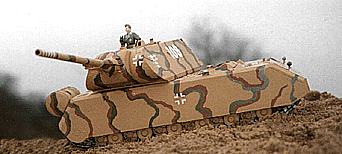
Model by Thomas Hartwig, Bremen Germany.
Panzerkampfwagen 'Maus'
Model by Thomas Hartwig, Bremen Germany.

The story of the super heavy tank 'Maus' is only now beginning to
become clear. With the fall of the Soviet Union, more and more information
about the "Soviet side" of World War II has come to light. With that information,
the history books must be re-written to refelct new information.
The official line in the West regarding the fate of both Maus prototypes
was that "they were blown up at Kummersdorf" to prevent their capture by the Soviets.
Though from one source or another I've heard a myriad of stories, including that one
was destroyed by a rampaging British Typhoon. Though, in a war where every
Panzer IV became a Tiger in the minds of the Wester Allies, perhaps every Tiger II
became a "Maus" upon further reflection.
With the fall of the Iron Curtain, however, it was revealed that the Soviet
tank museum at Kubinka had a Maus on display. Further examination of the vehicle suggested that it
combined the hull of one prototype with the turret of the second. According to
a new reference about the Kummersdorf proving ground, in the latter half of
1944 both Maus prototypes arrived at Kummersdorf for testing after final assembly
of the turret and chassis at F. Krupp. As the front approached nearer and nearer to
the testing facility, both Maus tanks were sent out to engage the approaching
Soviets. The vehicles were approaching Wünsdorf (crossing what is now highway
96) when the first Maus was disabled because of damage to the drive mechanism.
This vehicle was later captured by the Red Army. The second Maus managed to
proceed a few kilometers further before the crew destroyed it.
The Maus was a huge and impractical vehicle. The Waffenamt was leery of it
because of the producer, Dr. Porsche. Ferdinand Porsche was notorious for placing
a higher value on technical brilliance than servicability. The petrol-electric drive used in
every Tiger prototype designed by Porsche was carried over into the Maus design. There
does seem to be one important difference between previous petrol-electric designs and
the one in the Maus, the Maus design actually seems to have performed well in tests. Dr.
Porsche was also very demanding of his engineers. He had promised that the vehicle
would "turn in place" just like any other tracked vehicle. Given the size and weight of
Maus, the army was understandably skeptical. Just prior to a demonstration, some
of the engineers became a bit overzealous and took the vehicle out to test it. They excitedly
called Dr. Porsche indicating that Maus had indeed almost turned in place. Dr. Porsche
was furious, and rousted the engineer in charge of the sysem out of his sick-bed and
demanded an answer to this "problem." After a bit of looking, one spur gear was corrected and,
true to Dr. Porsche's word, Maus could turn in place.
Maus was far too heavy to use most bridges, so provision was made for
river and stream crossing underwater. As the drive was electric, one Maus could sit on the
bank with power cut to the electric drive and power the fording Maus via electrical cable using
it's petrol engine.
Armored protection on the Maus was amazing. Every surface which would be targetted
by other tanks was protected by no less than 180mm or armor, which maximum protection reaching
240mm. The top was, however, relatively vunerable as protection was typically 40mm. As with
most tanks, anti-aircraft protection would have been an absolute must.
The ever-increasing weight of Maus prohibited the use of the trademark
external torsion-bar suspension developed by Porsche. The bogie system used instead was
developed by Skoda. As with the Panzerkampfwagen E100, Maus was
to be ultimately fitted with a 15cm KwK44 or a 17cm KwK44.
| Panzerkampfwagen 'Maus' | |
|---|---|
| Crew: 5 | Armament: one 12.8cm KwK44 L/55 + one 7.5cm KwK44 L/36.5 + one 7.92mm MG34 |
| Weight: 188 tons | Traverse: 360o (power) |
| Length: 10.09 meters | Elevation: -7o +23o |
| Width: 3.67 meters | Engine: MB509 V12 1,080PS or MB517 Diesel |
| Height: 3.66 | Gearbox: 2 forward, 2 reverse (electric) |
| Radio: FuG5 | Speed: 20 km/hr |